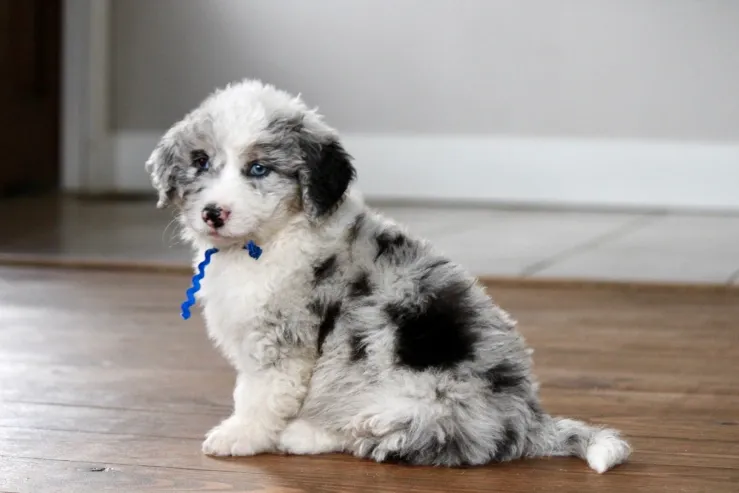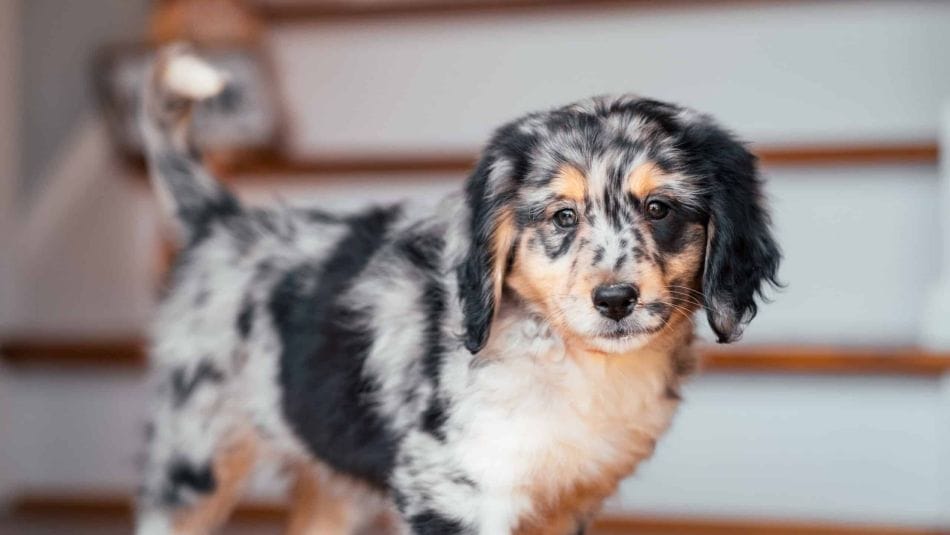The Mini Aussiedoodle, a cross between the Miniature Australian Shepherd and the Poodle, has been gaining popularity among dog lovers who are drawn to its friendly demeanor and appealing looks. As with many designer breeds, one question that stands out for potential owners is whether the Mini Aussiedoodle is hypoallergenic. This characteristic is a significant concern for individuals with allergies, as the presence of a pet should not compromise their health and comfort.

The term 'hypoallergenic' is used to describe breeds that are less likely to provoke an allergic reaction in humans. It's important to understand that no dog is completely hypoallergenic; however, some breeds produce fewer allergens than others. The Mini Aussiedoodle is often considered a good option for allergy sufferers due to the Poodle's reputation for being one of the breeds with a lower tendency to shed hair and dander.
Moreover, the Mini Aussiedoodle's coat type can influence its hypoallergenic properties. Typically, these dogs inherit the curly coat of the Poodle, which is known to trap dander and dead hair, preventing it from becoming airborne. This characteristic can reduce the spread of allergens around the home, thus potentially making the Mini Aussiedoodle a better choice for those with mild to moderate allergies. However, each dog is unique, and allergy sensitivities vary from person to person, necessitating a closer look into individual responses to this mixed breed.

Origins and Characteristics
The Mini Aussiedoodle is a deliberately bred crossbreed, a fusion of the Australian Shepherd and Poodle genetics, aimed at blending the traits of these two breeds.
Breeding History
The Mini Aussiedoodle is a hybrid dog, combining the Australian Shepherd and Poodle. Originally bred for a blend of intelligence, playfulness, and hypoallergenic potential, Aussiedoodles have gained popularity in recent years. The Australian Shepherd, despite its name, was developed in the United States and is known for its herding skills and active nature. The Poodle, known for its intelligence and low-shedding coat, comes in three sizes: standard, miniature, and toy. The breeding combination typically utilizes a miniature Poodle to achieve the 'mini' stature in Mini Aussiedoodles.
Aussiedoodle Traits
- Size: The Mini Aussiedoodle is smaller than the standard Aussiedoodle, generally weighing between 10 to 25 pounds (4.5 to 11.3 kg) and standing anywhere from 10 to 15 inches (25 to 38 cm) tall at the shoulder.
- Coat: They often inherit the Poodle's hypoallergenic coat, which is of particular interest to allergy sufferers. However, it's important to note that no dog breed is 100% hypoallergenic.
- Color and Patterns: The coat can come in a variety of colors and patterns, often reflecting the multicolored heritage of the Australian Shepherd parent.
- Temperament: Recognized for their intelligence and affectionate nature, Mini Aussiedoodles are energetic and thrive on social interaction and mental stimulation.
In terms of genetics, the mix of Australian Shepherd and Poodle genes can influence the traits of Mini Aussiedoodles, such as their hypoallergenic qualities, due to the presence of the Poodle's low-shedding attributes. However, because they are a crossbreed, the exact characteristics can vary between individuals.
Hypoallergenic Potential
Mini Aussiedoodles are often discussed in the context of hypoallergenic pets due to their Poodle ancestry; yet, it's essential to evaluate their hypoallergenic qualities.
Understanding Hypoallergenic Breeds
The term hypoallergenic implies a lower tendency to provoke allergic reactions. No dog breed is completely hypoallergenic, but breeds are considered hypoallergenic if they typically produce fewer allergens than others. Allergens are substances like dander, saliva, and urine that can cause allergy symptoms in sensitive individuals. Hypoallergenic breeds often have hair that grows in a single layer rather than a double coat, which reduces the spread of allergens.
- Hair: Tends to trap dander closer to the skin rather than releasing it into the environment.
- Dander: The chief allergen that causes reactions in humans, not the hair itself.
- Shedding: Less shedding means fewer allergens are released into the air.
Aussiedoodle Allergen Factors
Aussiedoodles, being a cross between an Australian Shepherd and a Poodle, inherit characteristics from both parents, including their coat type.
- Hair: Aussiedoodles typically have a Poodle-like coat that is more hair than fur, which may result in lower shedding.
- Dander Production: They produce dander, but the amount can be less than other breeds.
- Allergy Sufferers: Allergy sufferers might experience fewer allergy symptoms around Aussiedoodles; however, individual reactions can vary.
It's important to spend time with an Aussiedoodle before adopting to ensure compatibility, especially for those with allergies. Regular grooming and cleaning can also help minimize exposure to allergens.
Coat Types and Grooming
The coat type of a Mini Aussiedoodle affects its grooming needs. Understanding these varieties and the appropriate grooming practices is essential for maintaining the dog's health and appearance.
Aussiedoodle Coat Varieties
Mini Aussiedoodles may have different coat types: straight, wavy, or curly. The straight coat is less common and resembles the Australian Shepherd parent, offering a softer texture. The wavy coat is a blend of the Poodle's and Australian Shepherd's coats, providing a compromise between the two in terms of texture and maintenance. The curly coat is similar to a Poodle's and is often thought to be the best for allergy sufferers, as it may trap dander more effectively.
| Coat Type | Description | Allergen Level |
|---|---|---|
| Straight | Soft like the Australian Shepherd, minimal waves | Higher |
| Wavy | Mix of both parent breeds, soft, some waves | Moderate |
| Curly | Tight curls like a Poodle, retains dander | Lower |
Each coat type has different grooming requirements to prevent matting and manage shedding.
Grooming Essentials

Grooming a Mini Aussiedoodle involves several steps. They require regular brushing at least a few times a week with a pin or slicker brush to prevent tangles. Brushing not only helps with matting but can also distribute natural skin oils throughout their coat, keeping it healthy and shiny.
Bathing should occur approximately once a month or as needed, using a dog-specific shampoo to maintain skin and coat health. After bathing, it's important to thoroughly dry their coat to prevent any skin issues. In addition to brushing and bathing, grooming also includes ear cleaning, nail trimming, and teeth brushing.
| Grooming Need | Frequency | Notes |
|---|---|---|
| Brushing | Several times weekly | Prevents tangles, distributes oils |
| Bathing | Monthly or as needed | Use dog-specific shampoo |
| Ear Cleaning | As needed | Prevent infection |
| Nail Trimming | Monthly | Prevents overgrowth and discomfort |
| Teeth Brushing | Several times weekly | Maintains dental health |
It's important to start these grooming practices early in the dog's life to get them accustomed to the routine. Some Mini Aussiedoodles may require professional grooming, especially those with curly coats that are prone to matting. Regular grooming not only keeps the dog looking good but is also vital for their overall well-being.
Health and Lifespan
The Mini Aussiedoodle, a crossbreed between the Miniature Australian Shepherd and Miniature Poodle, is generally healthy with a lifespan of 10 to 15 years. Proper diet and regular exercise are crucial for maintaining their health.
Common Health Concerns
Mini Aussiedoodles may inherit health issues from either parent breed. Common concerns include:
- Hip Dysplasia: A malformation of the hip joint leading to pain and arthritis.
- Progressive Retinal Atrophy (PRA): A genetic condition that can cause blindness.
- Epilepsy: A neurological disorder that can lead to seizures.
- Patellar Luxation: Displacement of the kneecap causing lameness or irregular gait.
Early detection and treatment can help manage these conditions.
Maximizing Longevity
To promote a long, healthy life for a Mini Aussiedoodle, they require:
- Diet: A balanced diet tailored to their life stage, size, and activity level.
- Exercise: Regular physical activity to maintain a healthy weight and muscle tone.
Routine veterinary check-ups and timely vaccinations are also key. Owners should adhere to a preventive health care schedule recommended by their vet.
Behavioral Traits
The behavioral traits of Mini Aussiedoodles reflect a combination of intelligence, energy, and sociability. These aspects influence their temperament and the way they respond to training and socialization efforts.
Aussiedoodle Temperament
The Mini Aussiedoodle inherits a friendly and gentle nature from its Australian Shepherd and Poodle ancestors. They are known for being intelligent and energetic. This hybrid dog generally shows a loyal attachment to their owners, which makes them wonderful companions. However, their loyalty can sometimes lead to separation anxiety if they are left alone for extended periods. Daily exercise is crucial to maintain their mental and physical welfare, as it helps to channel their energy positively.
Training and Socialization
Mini Aussiedoodles are highly trainable due to their intelligence and eagerness to please. They respond well to consistent, positive reinforcement training methods. Early socialization is essential to prevent timidness and ensure they are well-adjusted. Introducing them to various people, pets, and environments can help develop their adaptability and maintain their friendly demeanor. Regular training sessions also serve as mental stimulation, which is as important as physical exercise for this breed.
Living with an Aussiedoodle
An Aussiedoodle is a hybrid dog breed that combines the intelligence of an Australian Shepherd with the hypoallergenic coat of a Poodle. These dogs are renowned for being family-friendly and adaptable to various living environments, whether it be an apartment or a house with a yard. Due to their Poodle heritage, they carry the potential to be more allergy-friendly for individuals sensitive to pet dander.
Adapting Your Home Environment
When welcoming an Aussiedoodle into your home, it is crucial to consider allergen management. Even though the Aussiedoodle is often marketed as an allergy-friendly breed, no dog is truly hypoallergenic.
- Allergen Reduction: Regular cleaning is essential. Use a vacuum with a HEPA filter to effectively capture pet dander.
- Air Quality: Consider an air purifier to keep the air in your home clean.
To maintain a healthy environment for your Aussiedoodle, ensure that your living space is free from clutter to minimize places where hair and dander can accumulate.

Daily Routines and Activities
Aussiedoodles possess high energy levels and intelligence, demanding regular mental and physical stimulation.
- Exercise Needs: They require daily exercise which can include long walks, runs, or active playtime.
- Mental Stimulation: Interactive toys or agility training can help keep their minds engaged and prevent boredom.
Their protective nature makes them vigilant family pets, but they should be trained properly to ensure that their protective instincts do not lead to excessive wariness or barking. Establishing a consistent daily routine helps in managing these characteristics effectively.
Choosing the Right Aussiedoodle
When selecting an Aussiedoodle, prospective owners should prioritize finding a reputable breeder and understanding the various size and generation options to ensure they make an informed decision.
Selecting a Breeder
Reputable Breeder: One should seek breeders who prioritize the health and wellbeing of their dogs. A reputable breeder typically provides health clearances for the puppies and their parents, and is transparent about their breeding practices. They are often willing to answer questions and provide detailed information about the lineage and temperament of their Aussiedoodles.
- Questions for Breeders:
- Can you provide health clearance documentation?
- What socialization and training practices do you use?
Size and Generation Options
Aussiedoodles come in various sizes and generations, each with distinct characteristics:
- Size:
- Mini Aussiedoodle: Generally weighs between 15 and 35 pounds.
- Standard Aussiedoodle: Larger in size, typically over 35 pounds.
- Generation Options:
- F1 Aussiedoodle (50% Australian Shepherd and 50% Poodle)
- F1b Aussiedoodle (75% Poodle and 25% Australian Shepherd)
- F1bb Aussiedoodle (More Poodle genetics, often sought for hypoallergenic qualities)
- F2b Aussiedoodle (A mix involving second-generation Aussiedoodles)
- F2bb Aussiedoodle (Further generations with varying percentages of Australian Shepherd and Poodle)
- Average Price: The price of an Aussiedoodle can vary, reflecting the breeder's reputation, the puppy's generation, and size. The average price usually ranges from $1,000 to $5,000.
Selecting the right size and generation of Aussiedoodle will affect the compatibility with the owner's lifestyle and may influence potential hypoallergenic traits.
Frequently Asked Questions

Mini Aussiedoodles are popular for being affectionate and potentially low-shedding, a trait potentially attractive to allergy sufferers. Understanding the specifics of their coat and care requirements can help in managing allergies.
Q1: What factors contribute to the hypoallergenic qualities of a Mini Aussiedoodle?
The hypoallergenic qualities of a Mini Aussiedoodle are largely due to their Poodle genetics. Poodles are known for their tightly curled coat that minimizes dander and shedding key triggers for allergies.
Q2: How does the shedding of a Mini Aussiedoodle compare to other hypoallergenic breeds?
Mini Aussiedoodles typically shed less than many dog breeds, including some that are labeled hypoallergenic. However, shedding can vary based on the individual dog and its specific genetic mix.
Q3: To what extent does the Poodle heritage influence the hypoallergenic properties of a Mini Aussiedoodle?
The Poodle heritage significantly influences the hypoallergenic properties of Mini Aussiedoodles. The gene for the Poodle's non-shedding coat is dominant, meaning that Poodle mix-breeds often inherit this desirable trait.
Q4: Are there specific grooming practices recommended for reducing allergens in Mini Aussiedoodles?
Regular grooming, including brushing and bathing, is recommended to minimize allergens in Mini Aussiedoodles. Keeping their coat trimmed can also help to reduce the presence of allergens.
Q5: What are the typical characteristics of a Mini Aussiedoodle's coat, and how do they relate to allergies?
A typical Mini Aussiedoodle's coat can range from straight to curly and is relatively low-shedding. The amount of dander and allergens released can be less, making them a potentially good choice for individuals with allergies.
Q6: How do Aussie Shepherds' hypoallergenic properties differ from those of Mini Aussiedoodles?
Aussie Shepherds are not considered hypoallergenic and generally shed more than Mini Aussiedoodles. The difference in shedding is due to the Aussie Shepherd's double coat, which releases more allergens into the environment.




